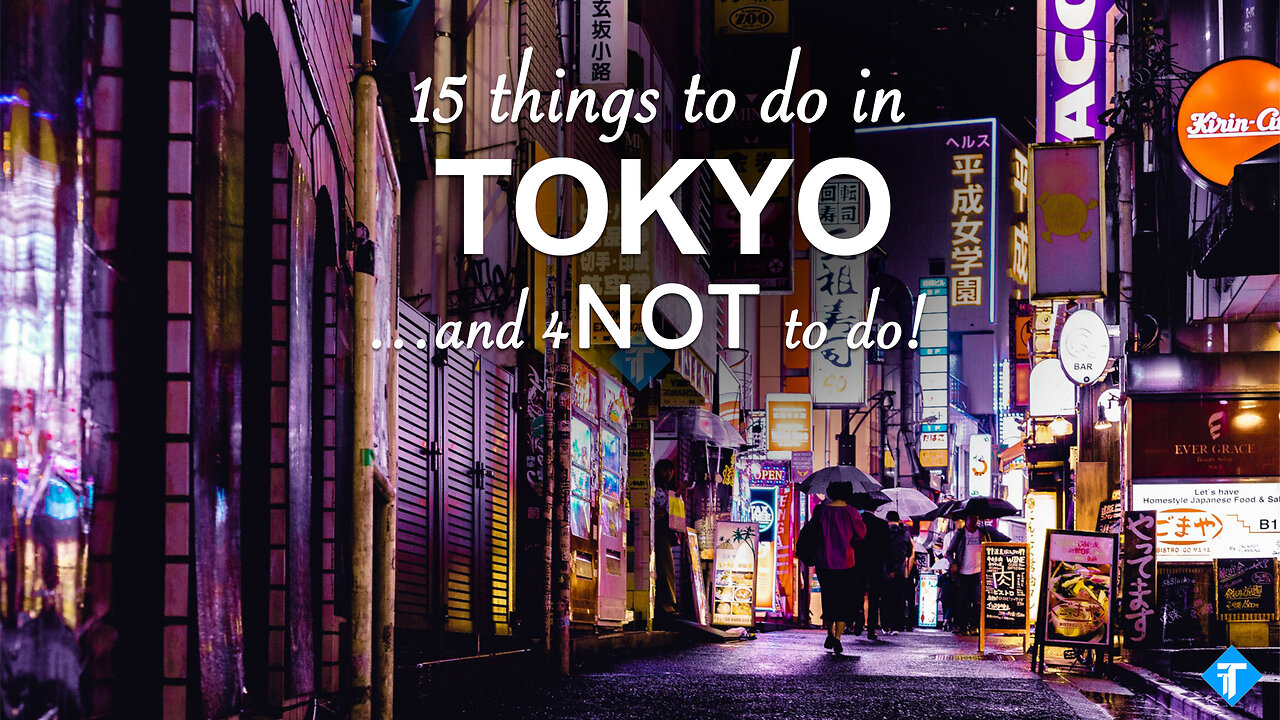Premium Only Content

15 Things to do (and 4 NOT TO DO) in Tokyo - Japan Travel Guide
Tokyo is an eclectic city, an incredible mix of imperial palaces, shrines, temples, but also avant-garde neighborhoods full of huge skyscrapers. Tokyo is a symbol of relaxation, thanks to the presence of the well-known Onsen, the typical thermal baths. But at the same time it is also a dynamic city, full of themed bars and seemingly anonymous alleys, which in reality hide its truest soul. Not to mention the karaoke, pachinko and ubiquitous arcades. In short, a city that never sleeps and, above all, with 1,000 facets. A city that can stun and baffle at first glance, so much so that, after "the first time", you either fall in love with it or hate it!
1. Asakusa and Senso-Ji Temple.
Compared to modern neighborhoods, Asakusa has an old-world charm, reminiscent of the days when Tokyo was known as Edo.
In the heart of the district, and the main reason to visit the district itself, is the famous Sensoji Temple, considered the oldest structure in Tokyo, as well as the main Buddhist sacred place belonging to the Tendai sect.
Legend has it that 2 brothers, in 628, fished a statue of the goddess Kannon in the Sumida River. Though they tried to put it back in the river, it always came back to them. That is why the temple dedicated to her was built near the river in 645, making it the oldest temple in Tokyo.
To access it, you must pass the thousand-year-old Kaminarimon gate, the very symbol of Asakusa. After the imposing entrance, to get to the temple you have to go along the shopping street, the so-called Nakamise Dori, where you can buy souvenirs and local specialities. Still on the theme of shopping, in this district a stroll in Kappabashi Dori is fun, the street where more than 100 shops selling kitchen utensils are concentrated.
Many green areas develop along the Sumida River. A visit to the neighborhood can be considered complete by climbing the Tokyo Skytree observatory, the tallest building in the country, from where you can enjoy breathtaking views over the city.
2. National Museum.
Located inside Ueno Park, the Tokyo National Museum offers the largest collection of Japanese art in the world. There are relics that relate to the history of the nation: from the Jomon period to the Edo period.
There are ceramics, masks and paintings. The Japanese gallery, the Asian gallery, the treasure gallery of Hōryū-ji temple, a research center, a garden and various restaurants and shops are also part of the museum complex. It is an obligatory stop to get to know Japanese culture better, from all its sides.
This museum has changed its name several times throughout its history. First Imperial Museum, then Tokyo Imperial Household Museum, today it is simply called TMN. In 1923 this building was also heavily damaged during the earthquake that caused at least 100,000 victims in Japan.
3. Ueno Park.
The green lung of Tokyo is located in the heart of the district of the same name. It was once part of the Kaneiji Temple, which however was destroyed at the end of the 19th century. Today, inside the park, some remains can still be admired.
Here it is possible to do activities in contact with nature and animals, but also to admire small temples and visit museums inside. There are about 8,000 trees and in the center there is an island that houses the sanctuary dedicated to Benzaiten, goddess of fortune. The park and its attractions attract over ten million visitors a year, making it Japan's most popular city park.
Unusually, there are a large number of homeless people living within the park. Although wandering is illegal in Japan, here their presence is accepted as inevitable.
4. Shinjuku.
The most representative district of Tokyo. The neighborhood that never sleeps, where you are constantly dazed and dazzled by music and neon lights, and where you can find everything.
It's also the best neighborhood to look for accommodation, both because it's well connected to all other areas of Tokyo, and because there's no danger of getting bored in the evening!
The area of Shinjuku where nightlife and entertainment are concentrated is Kabuki-cho. A red sign identifies the entrance. Here you will find any type of club, even if there is a high concentration of gambling halls, Pachinko, and the various "prostitute" clubs (service not allowed for foreigners). It seems that the interference of the Yakuza, the Japanese mafia, is strong in the neighborhood, but there are no particular dangers. In order not to risk getting lost, especially in the evening, it is better for the first time to opt for a guided evening tour of Shinjuku, among the typical izakaya clubs, red light districts and tastings.
5. Golden Gai.
It is located in Kabuki-cho, the Shinjuku district that never sleeps. It is an area characterized by alleys with about 200 tiny bars able to accommodate very few people: from 5 to a maximum of 10 customers each. Here the atmosphere is really friendly and making friends with the few customers present is practically automatic.
The Golden Gai restaurant's specialty is yakitori, small skewers of meat (usually chicken). In the past this place was famous as it was very popular with artists, musicians, actors and directors. Very suggestive in the evening when obviously all the places are crowded and the alleys are lit up by lanterns.
6. Meiji Shrine - Meiji Jingu.
Immersed in a large park, the Meiji Shrine is a jewel of the Shinto religion that offers visitors an oasis of peace and tranquility, just a few steps away from the busy Harajuku station. It is one of the most symbolic sacred places in Tokyo and most loved by the Japanese as it venerates the figures of the Emperor Meiji and his wife, the Empress Shoken. Emperor Meiji's life is chronicled in the 2003 film "The Last Samurai".
In addition to a pleasant and relaxing walk in Yoyogi Park, you can admire the Naien park (main garden), the area with the sacred buildings, which also includes a museum where relics of the imperial family are kept, and finally the external area o Gaien, characterized by the gallery of Meiji paintings, a collection of eighty illustrations depicting key events in the life of the emperor and his wife.
It is not uncommon to see Shinto weddings celebrated. The sanctuary is very crowded during the autumn festival and the first days of the year when the faithful go there to pray and make offerings as auspicious for the new year.
7. Harajuku.
Sandwiched between Shinjuku and Shibuya, this neighborhood is the heart of youth culture and new trends. The nerve center of the neighborhood develops around Takeshita Dori, a long avenue teeming with clothing and accessory shops, vintage boutiques, fast food and food stalls intent on satisfying the palate of young people (a riot of ice cream parlors and sweets and sweets shops ranging from unacceptable colors!). Harajuku is most famous for the presence of cosplayers who gather in this area on weekends. These are young people who are so passionate about a character that they identify with him, emulating him to the point of dressing up and acting exactly like him.
South of Takeshita Dori is the elegant and wide tree-lined Omotesando avenue, nicknamed the "Champs-Elysees of Tokyo", where boutiques of famous brands, restaurants and elegant cafés alternate. In this district, just behind the subway station, is the Meiji Jingu, one of the most important shrines in Tokyo, immersed in the enchanting Yoyogi Park, an oasis of peace and tranquillity.
8. Shibuya.
Known for the famous intersection, the busiest in the world, which has become its symbol, Shibuya is the district of young people and new trends. With its lively soul at any time of day, it is an ideal neighborhood for shopping and having fun, discovering strange and curious shops and clubs, bars, karaoke, pubs, discos and pachinko (Japanese gambling).
During the night, the alleys acquire a unique charm thanks to the neon lights and the signs of the various shops. And every time the traffic light of the famous intersection turns green, a flood of people pours into the street making the atmosphere even more suggestive.
Just outside the station, in the square, there is another famous attraction, the statue of the dog Hachiko. You will recognize it from afar because there is usually a line of people who want to take a selfie in front of the statue.
9. Roppongi.
It is an extremely multicultural area of Tokyo, home to various embassies and therefore frequented by expats, but above all it is one of the liveliest districts at night, characterized by a vibrant atmosphere due to the many bars and restaurants present here.
It is a redeveloped area, full of luxury hotels, offices, shops and much more. Furthermore, thanks to the presence of some art museums, the district is increasingly becoming an important cultural centre.
Among the symbolic skyscrapers of the neighborhood we find the Mori Tower, which houses the offices of major international brands such as Goldmann Sachs, Lehaman Brothers, TV Asahi and Yahoo, and many others.
10. Imperial Palace.
It is the main official residence of the Japanese Emperor. The building is located in a small park and is located near the city station.
The complex houses various structures, including the Kyūden palace, the private residence of the Imperial Family, and beautiful gardens that can only be visited by booking online.
The Palace is open to visitors only twice a year: on 2nd January to welcome the new year, and on 23rd December, on the birthday of the current emperor. On these two occasions, the imperial family shows itself to visitors from the main balcony.
The East Gardens, the surrounding gardens, are always open to the public. Developed over an area of 210,000 square meters, in the past they housed the defense buildings of the Edo castle; the walls, the moat and the entrance gates are still present as well as the foundations of the ancient castle tower. They are very nice to visit in the spring during hanami (cherry blossom). Possibility to rent a small boat to navigate the waters of the moat.
11. Kanda.
Outside the traditional tourist circuits is Kanda, a residential district located between Tokyo Station and Ueno. Academic center of the capital, here there are historic universities and a good number of temples and shrines of great importance. Don't miss the Kanda-Myojin Shrine, where every year, on New Year's Eve, those who run their own businesses go on pilgrimage to ask for a prosperous year. Instead, students go to the Mausoleum of Confucius to ask for good grades in exams and buy votive pencils.
It is also very interesting to stroll through characteristic and thematic streets: via Ochanomizu where there are musical instrument shops and Jimbocho full of bookshops and cafés. For enthusiasts, a visit to the Origami Kaikan is interesting. Area also recommended for gourmets; in fact, in this district there are more than 30 restaurants specializing in curry, a specialty for which a party is even dedicated in the month of November.
12. Akihabara.
It is the otaku paradise, young people obsessively dedicated to a particular activity, hobby or interest (specifically comics, cartoons, video games and computers). In fact, here there is a continuous succession of shopping centers that sell electronic products and above all shops related to the manga and anime universe.
In addition to the shops of the aforementioned kind, there are also numerous maid cafes and Neko cafes here. In the first courses you will be served, spoiled and pampered by young waitresses dressed as nineteenth-century waitresses, complete with apron and crinolines, who will welcome you inside the restaurant with "Welcome / Welcome back my lord"; in the latter you can sip a coffee cuddling the cat that makes you most tender.
The district can be reached with the Yamanote Line, up to the Akhiabara stop.
13. Tsukiji Fish Market.
The largest fish market in the world, characterized by an internal area dedicated to wholesalers, famous throughout the world for the tuna auction, and the external area where the fish is processed and sold in retail. Inside are the best sushi restaurants in Tokyo.
Waking up very early, here you will be able to attend the famous tuna auction. However, you have to show up early in the morning around 4:30 and be lucky enough to be among the first 120 who show up at "The Fish Information Centre".
14. Ginza.
Ginza is the "classy" district of Tokyo, where there are mainly high fashion shops with futuristic architecture, excellent and expensive restaurants, shops of all the biggest fashion houses in the world, such as Chanel, Dior, Hermes and many others. There are also numerous shopping malls. In short, the place to indulge in luxury shopping. For an exclusive experience, we recommend opting for a guided tour of the neighborhood, to discover Ginza through the eyes of a local.
During the weekend, the main road is closed to traffic and becomes a pedestrian area, in order to encourage visits and shopping by residents and tourists. Nearby we can admire the Clock Tower (Wako).
15. Tokyo Tower.
Used for telecommunications, and with a design reminiscent of the famous Parisian Eiffel Tower, this tower is the symbol of Tokyo. From the terrace at the top of the tower you can enjoy an extraordinary 360° panoramic view of the city. An evening visit is particularly recommended, especially towards sunset. Online ticket recommended to avoid queues at the entrance.
Inside there are the FootTown, a four-story shop located at the base, and two observation platforms, the first positioned at a height of 150 meters and the second at 250 meters. In its vicinity, the Roppongi district, within which Roppongi Hills is located, a sort of mini-city within Tokyo.
16. Warnings.
Take the trash with you. In the city there are few bins, concentrated in the stations, if you have rubbish take it with you and don't leave it around (or, worse, put it in the can bins near the vending machines, for example).
Don't eat while walking. This is strange to understand but even street food is not consumed while walking: either you eat it on the spot or you take it with you to a suitable place (it is instead acceptable on long-distance trains).
Do not smoke outside the designated spaces. You do not smoke outdoors, while you can almost always smoke indoors. The alternative is the small smoking areas scattered throughout the cities.
Silence on the trains. On the subway, but also on surface trains, one should remain silent: at the most, one speaks in a low voice and does not call. Another thing, take the backpack off your shoulders, especially when the train is crowded.
-
 LIVE
LIVE
Tommy's Podcast
7 hours agoE725: Nosler, Oregon
13,889 watching -
 2:07:58
2:07:58
Badlands Media
1 day agoDevolution Power Hour Ep. 353: American Pope, Weaponized Justice, and Trump’s Constitutional Endgame
104K36 -
 1:22:31
1:22:31
Man in America
23 hours agoCancer Patient Becomes Drug Smuggler to Save His Own Life w/ Rick Hill
60K25 -
 56:47
56:47
Tundra Tactical
8 hours ago $12.09 earned$3200 ZEV HEARTBREAKER Contest!!! Green Beret Talks Plate Carriers With Tundra Tactical
54.3K1 -
 2:14:45
2:14:45
megimu32
8 hours agoON THE SUBJECT: SATURDAY NIGHT SPECIAL
32.4K2 -
 4:44:32
4:44:32
Mally_Mouse
12 hours agoSaturday Shenanigans!! - Let's Play: Party Animals
62.1K4 -
 2:33:25
2:33:25
FATTACnation
18 hours agoConversations between Real People.
34.3K2 -
 52:30
52:30
The Mel K Show
10 hours agoMel K & Bx - Becca Spinks | Uncovering Evil: Our Children Are Being Targeted | 5-10-25
77.8K35 -
 17:10
17:10
Tundra Tactical
10 hours ago $5.01 earnedEXCLUSIVE Zev Heartbreaker Pistol Hands-On Review!
54.4K3 -
 12:31:41
12:31:41
Total Horse Channel
21 hours agoBest Little Derby in the West | Main Arena | Saturday
73.4K6